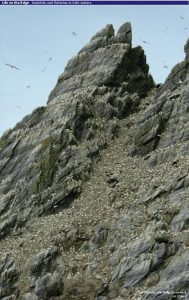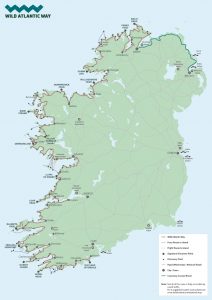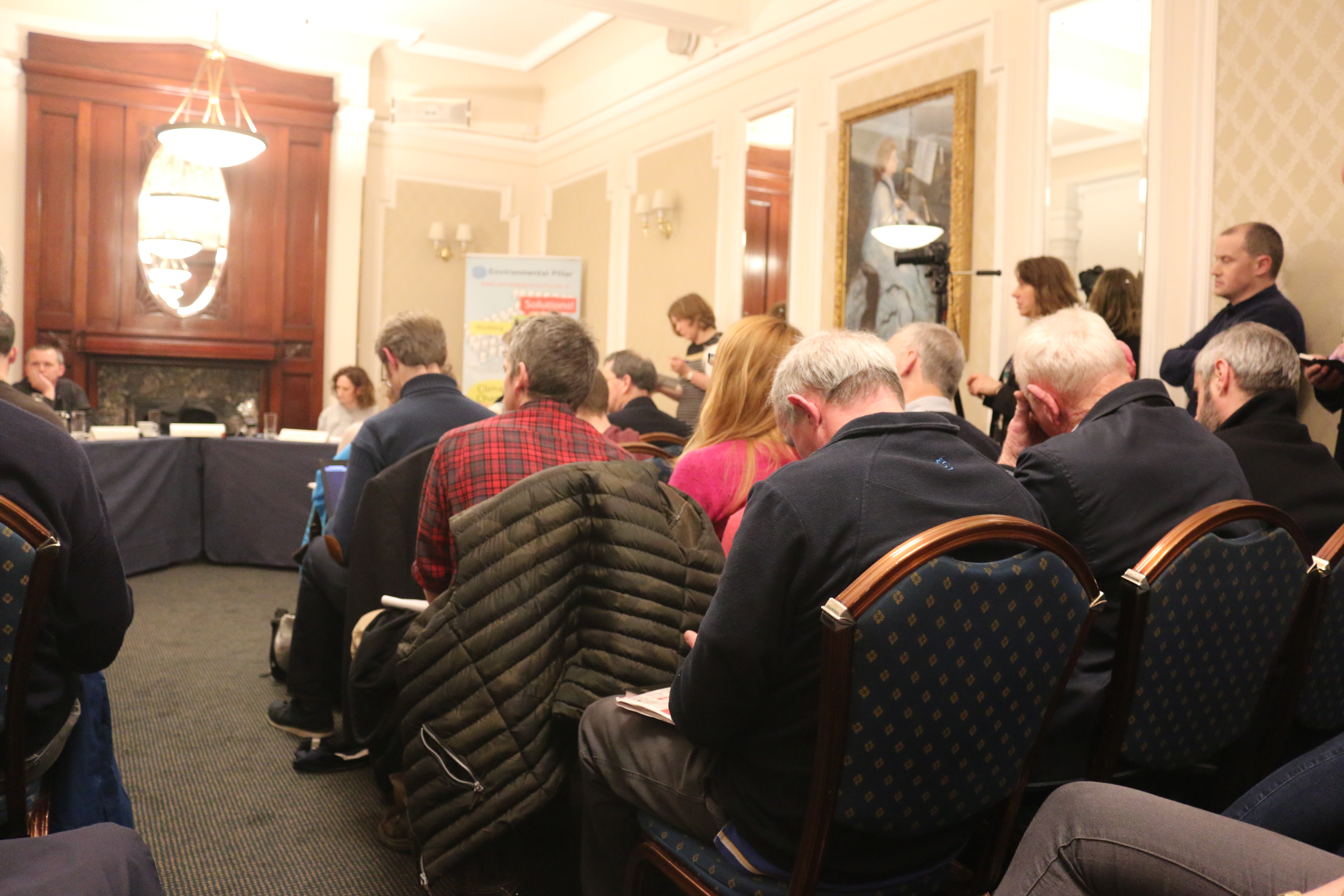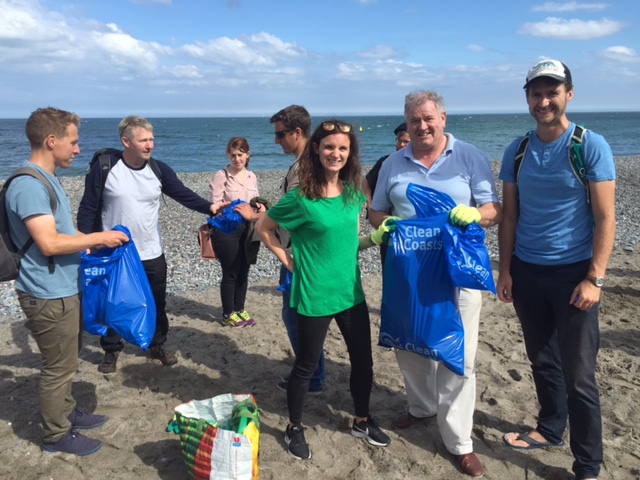Seabirds of the Wild Atlantic Way in jeopardy cautions new report by Birdwatch Ireland
Image: Sooty Shearwater Seabird Photographer: Anthony McGeehan
November 28, 2016
BirdWatch Ireland launched their annual report entitled ‘Life on the Edge : Seabirds and fisheries in Irish waters’ in Buswells Hotel last Friday (November 25). The report explores the interactions between fisheries and seabirds including the knock-on effects of food shortages (e.g. fish) on seabird breeding success; the impacts of seabird bycatch and the opportunities to implement measures which will directly benefit seabirds. One of the most important measures is helping to achieve Common Fisheries Policy objectives which are sustainable over the long-term.
GPS tracking has demonstrated that seabirds are now travelling longer distances in search of food. Overfishing has thinned out the food supply and puts significant strain on our seabirds population. According to the report Ireland’s rugged coastline, including the world-famous Wild Atlantic Way, which spans some 7,500 kilometres, and its vast marine waters support hundreds of thousand of seabirds. Irish shores are home to globally important numbers of breeding Manx Shearwater and European Storm-petrel. Some of our seabirds form spectacular colonies and the Northern Gannet (pictured here to the right) form ‘high rise’ settlements such as on little Skellig, a small island off the coast of Co. Kerry.
Fisheries affect seabirds by competing for the same types of fish in the same locations, additionally fisheries can have a direct impact on seabird mortality by entanglement and trapping in fishing gears. The problem is compounded by the trend of European fishing limits being set above the recommendations made based on scientific advice. The report calls for greater transparency in decision making and data used to come to decisions in the upcoming December Agriculture and Fisheries Council to be held on December 12-13.
Ireland is home to some 20,000 breeding pairs of Atlantic Puffins in summer (pictured here to 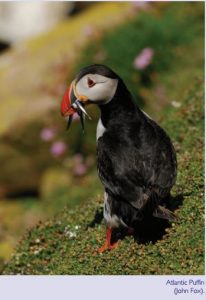 the right). Decreasing abundance of fish loved by Atlantic Puffins has resulting in adults choosing sub-optimal prey for their young, these can be choking hazards for the chicks and are far less nutritious. Given that national monitoring of these iconic seabirds involve decadal surveys at best, subtle changes in food availability and its impact on fecundity will be problematic. This is of particular significance since the Puffin has recently been added to the European Red List.
the right). Decreasing abundance of fish loved by Atlantic Puffins has resulting in adults choosing sub-optimal prey for their young, these can be choking hazards for the chicks and are far less nutritious. Given that national monitoring of these iconic seabirds involve decadal surveys at best, subtle changes in food availability and its impact on fecundity will be problematic. This is of particular significance since the Puffin has recently been added to the European Red List.
The European Red List is a review of the status of European species according to IUCN Regional Red Listing guidelines. It identifies those species that are threatened with extinction at the European level (Pan-Europe and the European Union) so that appropriate conservation action can be taken to improve their status.
The birds are considered to be icons of the Wild Atlantic Way which draws millions of tourists from around the globe, particularly during the summer months when the Puffins are visitors to Ireland’s numreous sea-stacks and cliffs. The west coast is the best place to see and hear them, especially at the Cliffs of Moher in Co. Clare, as well as Horn Head in Co. Donegal accessible sites, though there is a scattering of smaller colonies at east-coast sites, including Ireland’s Eye and Lambay Island and Great Saltee Island. Skellig Michael in Co. Kerry, with its world-renowned 6th-8th Century monastic settlements, a UNESCO World Heritage Site, is perhaps the most spectacular home to Atlantic Puffins. Nearby Puffin Island, closer to mainland Kerry, also holds important populations of Manx Shearwaters and European Storm-petrels. These sites are cornerstones of the Wild Atlantic as they offer beautiful examples of unspoiled coastline habitats for seabirds including rare colonies and endangered species.
The Wild Atlantic Atlantic is an official tourist trail which was launched in 2014 by Minister for Tourism and Sport Michael Ring. The trail includes 2,500 kilometres of attractions that closely skirt the coastline of the west of Ireland. It incorporates the Celtic-Sea attractions that are the native habitat of many of the seabirds discussed in this year’s Life on the Edge report, including the Skellig Rocks pictured above, as well as the Cliffs of Moher and the Shannon Estuary, all sites where our native seabirds contribute to the experience. The unique offering of the Wild Atlantic Way lies in just what its title alludes to : its wildlife. The area is free of the urban sprawl which occupies a far greater volume of land on the east coast of Ireland. The southwest coast is also home to Sheep’s Head an award winning site European Destination of Excellence for Sustainable Tourism in 2009 and listed as ‘Best Destination’ in the World Responsible Tourism Awards 2015.
The unspoiled biodiversity of the Wild Atlantic Way is at the heart of its global renown. This natural relatively undeveloped coastline is rare and this ‘wild charm’ is what draws visitors from around the globe. Healthy fish populations bolster healthy seabird populations and contribute to the overall biodiversity of the region. Ensuring that fish quotas are set according to objective scientific advice rather than according to the demands of lobbyists is essential to maintaining a sustainable balance for the region.
Additional training can help to minimise by-catch and entrapment of seabirds. One of the key messages in the report is that sustainability is a very reachable goal. Quality data, and favouring sustainability safeguard the long term interest of the fishing industry. The report also call for a balancing of industry data with with biodiversity needs in order to set the correct path for the long-term.
In addition to the man-made changes occurring in Irish seas there are also environmental changes having an observable effect. For example, mackerel are shifting north to Iceland as climate change causes the temperature of the northern seas to increase. The report highlights the need for better monitoring of small forage fish. Over the next four to five years the report suggests that a focus be placed on workshops and continued education for fishermen as well as increased monitoring of super-trawlers.
The uncertainty surrounding Brexit and the impact this will have on fishing quotas and the future of fishing in the region looms on the horizon. In the meantime work needs to be done to improve the quality of data collected on seabirds, as well as to pressure European decision makers to factor in sustainability and scientific data over short-term industry needs.
Click below for the full report:
[x_button shape=”square” size=”regular” float=”none” href=”http://www.birdwatchireland.ie/LinkClick.aspx?fileticket=SlJ1VfMzL6g%3d&tabid=1441″ title=”Life on the Edge : Seabirds and fisheries in Irish waters 2016″ info=”none” info_place=”top” info_trigger=”hover”]Life on the Edge : Seabirds and fisheries in Irish waters 2016[/x_button]
[x_author title=”About the Author”]
